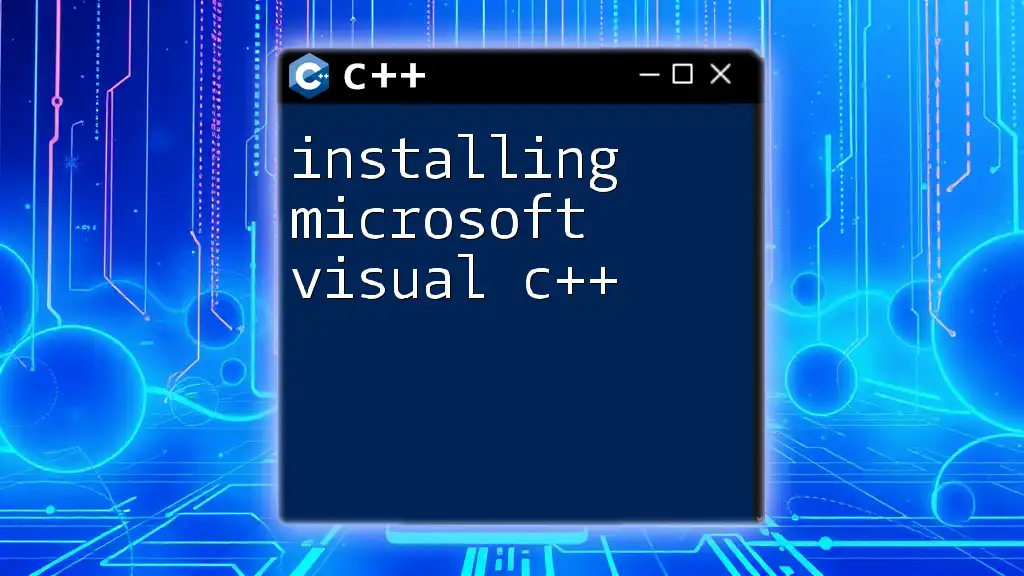To install Microsoft Visual C++, download the Visual Studio installer from the official Microsoft website and select the “Desktop development with C++” workload during installation.
// Example command to install Visual Studio using the command line (for Visual Studio 2019)
vs_Community.exe --layout C:\packages --lang en-US --add Microsoft.VisualStudio.Workload.NativeDesktop
System Requirements
Before you proceed with installing Microsoft Visual C++, it's important to ensure that your system meets the required specifications.
Minimum Requirements:
- Processor: A 1.8 GHz or faster processor.
- RAM: At least 2 GB of RAM; 4 GB is recommended.
- Disk Space: At least 20 GB of available space for installation.
Recommended Requirements:
For optimal performance, consider the following:
- Processor: 2.4 GHz or faster processor.
- RAM: 8 GB or more.
- Disk Space: SSD (Solid State Drive) with a minimum of 100 GB free space for quick load times.
Downloading Microsoft Visual C++
To install Microsoft Visual C++, you'll need to download it from an official source to ensure the integrity of the software.
Where to Download:
Visit the official Microsoft website for Visual Studio. Make sure to verify that you are on the legitimate Microsoft site, as downloading from untrusted sources can pose security risks.
Selecting the Right Version:
There are several editions of Microsoft Visual C++ available for download:
- Community Edition: Free for individual developers and small teams; contains all the essential tools for C++ development.
- Professional Edition: Paid version that includes additional features for enterprise-level development.
- Enterprise Edition: Designed for larger organizations; includes advanced tools and capabilities for breaking down complex projects.
Choose the version that best fits your needs. For beginners, the Community Edition is a sufficient starting point.
Installation Steps
Once the download is completed, follow these steps to install Microsoft Visual C++:
Running the Installer:
Double-click the installer file you downloaded. This action will launch the Visual Studio Installer.
Choosing Components:
As the installation process runs, you will see a screen with several component options.
Essential Tools to Select:
- C++ Desktop Development Tools: This is the core of your installation, allowing you to create Windows desktop applications in C++.
- Windows SDK: Necessary for developing Windows applications, as it includes tools and headers you may need.
Optional Components:
If you're interested in expanding your programming skills, consider additional tools:
- Game Development Tools: If you aim to develop games using C++.
- Mobile Development Tools: Useful if you're interested in cross-platform mobile app development with C++.
Configuration
The configuration is the next step after choosing the components. The installation wizard guides you through it intuitively.
Setting Up the Environment:
After selecting your desired components, click “Install” and wait for the progress to complete. You may also choose to configure the installation settings according to your system's specifications for an optimal workflow.
Here's a simple code snippet that you can compile later in Visual C++:
// This is an example of a simple C++ program
#include <iostream>
int main() {
std::cout << "Hello, World!" << std::endl;
return 0;
}
Launching Microsoft Visual C++
Upon completion of the installation, you can launch Microsoft Visual C++ for the first time.
First Steps After Installation:
When you open the IDE, you will be greeted with a start window. You can choose to open an existing project or create a new one.
Creating a New Project:
- Click on “Create a new project.”
- Select 'Console Application' under C++.
- Follow the prompts to name and configure your new project.
Writing a Simple Program
Now that your environment is set up, let’s write a straightforward C++ program.
Code Example:
To create your first C++ application, write this simple 'Hello World' program:
#include <iostream>
int main() {
std::cout << "Hello, World!" << std::endl;
return 0;
}
Compilation Process:
To compile your code:
- Save your file with a `.cpp` extension.
- Click on the "Local Windows Debugger" button to compile and run your program.
If there are any errors, Visual C++ will inform you of the issues in the code, and you can troubleshoot by reviewing the error messages.
Debugging C++ Programs
Debugging is a critical part of the development process, and Visual C++ offers robust tools for this.
Using Built-in Debugging Tools:
You can set breakpoints in your code by clicking in the margin next to a line of code. This allows you to pause execution and inspect the values of variables to diagnose problems.
Additional Tools and Extensions
To enhance your coding experience, consider adding some popular extensions available for Visual Studio.
Popular Extensions for C++ Development:
Some useful extensions include:
- Visual Assist: Improves code navigation and refactoring.
- C++ Code Snippets: Provides a library of reusable code segments.
How to Install and Manage Extensions:
You can add extensions by going to the Extensions menu in Visual Studio, selecting "Manage Extensions," and browsing or searching for desired tools.
Conclusion
You have successfully completed the steps for installing Microsoft Visual C++, launching it, and even writing a simple program. This foundational setup opens the door to exploring the world of C++ programming, where you can build various applications.
Frequently Asked Questions (FAQ)
Common Issues During Installation:
- Installation Fails: Ensure your system meets minimum requirements and that there is adequate disk space.
- Component Selection Errors: If you selected the wrong components, you can modify your installation through the Visual Studio Installer.
Where to Get More Help:
If you face difficulties, the Microsoft documentation provides comprehensive guidelines. Additionally, online forums and programming communities can be great resources for troubleshooting and learning.
Call to Action
Now that you have Visual C++ installed, it’s time to jump into coding! Explore sample projects, experiment with the code, and consider enrolling in more advanced C++ courses to deepen your programming skills. Happy coding!








